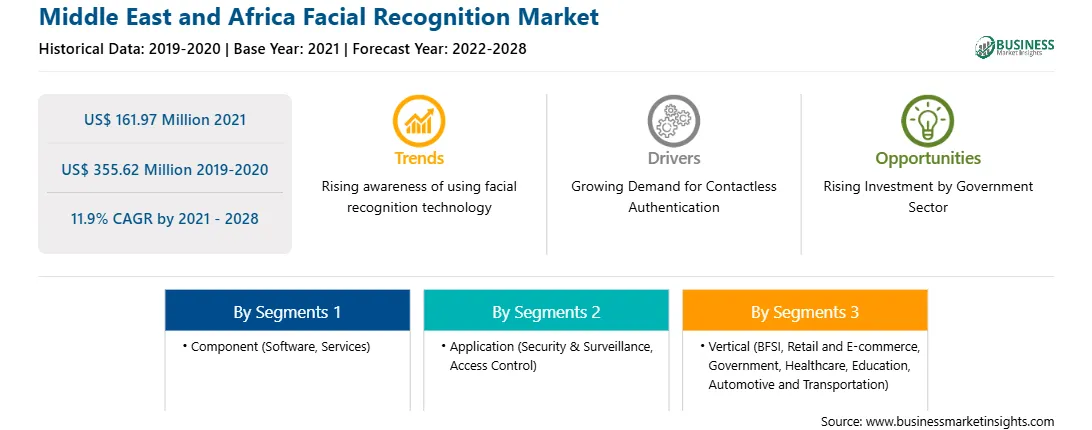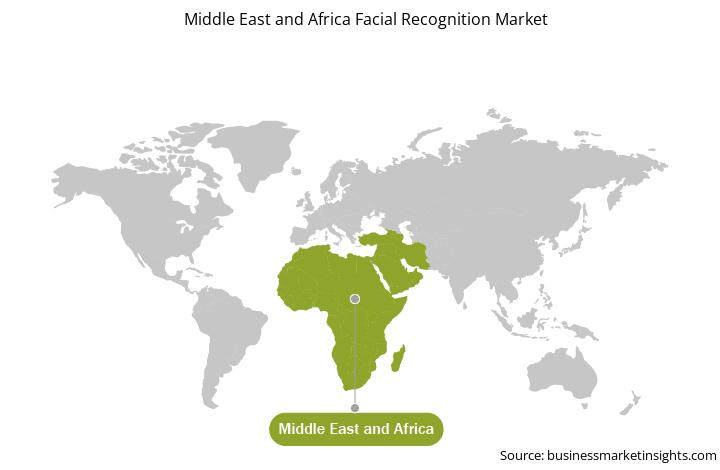Middle East and Africa Facial Recognition Market
No. of Pages: 116 | Report Code: TIPRE00029033 | Category: Technology, Media and Telecommunications
No. of Pages: 116 | Report Code: TIPRE00029033 | Category: Technology, Media and Telecommunications
The “fourth industrial revolution,” Industry 4.0, is characterized by rapid and converging advancements in multiple next-generation technologies, including artificial intelligence (AI). The newly developed facial recognition systems use advanced artificial intelligence features, IP cameras, machine learning algorithms, and cognitive technology to verify a person from a video source or a digital image. While traditional facial recognition systems have loopholes, advanced AI-based facial recognition systems deliver far superior accuracy. Moreover, many companies are eliminating traditional fingerprinting scanners from their security systems, which is paving the way for the greater adoption of AI-based facial recognition systems. In addition, apart from technology giants, the military sectors are also planning to adopt the AI technology for AI-based battlefield challenges. Thus, AI-powered facial recognition technology is bolstering the market growth. Moreover, increasing government initiatives and investments in promoting AI-based facial recognition technologies are further propelling the facial recognition market growth.
Strategic insights for the Middle East and Africa Facial Recognition provides data-driven analysis of the industry landscape, including current trends, key players, and regional nuances. These insights offer actionable recommendations, enabling readers to differentiate themselves from competitors by identifying untapped segments or developing unique value propositions. Leveraging data analytics, these insights help industry players anticipate the market shifts, whether investors, manufacturers, or other stakeholders. A future-oriented perspective is essential, helping stakeholders anticipate market shifts and position themselves for long-term success in this dynamic region. Ultimately, effective strategic insights empower readers to make informed decisions that drive profitability and achieve their business objectives within the market.

| Report Attribute | Details |
|---|---|
| Market size in 2021 | US$ 161.97 Million |
| Market Size by 2028 | US$ 355.62 Million |
| Global CAGR (2021 - 2028) | 11.9% |
| Historical Data | 2019-2020 |
| Forecast period | 2022-2028 |
| Segments Covered |
By Component
|
| Regions and Countries Covered | Middle East and Africa
|
| Market leaders and key company profiles |
The geographic scope of the Middle East and Africa Facial Recognition refers to the specific areas in which a business operates and competes. Understanding local distinctions, such as diverse consumer preferences (e.g., demand for specific plug types or battery backup durations), varying economic conditions, and regulatory environments, is crucial for tailoring strategies to specific markets. Businesses can expand their reach by identifying underserved areas or adapting their offerings to meet local demands. A clear market focus allows for more effective resource allocation, targeted marketing campaigns, and better positioning against local competitors, ultimately driving growth in those targeted areas.

The Middle East & Africa facial recognition market is segmented on the basis of component, application, vertical, and country. Based on component, the market is segmented into software and services. In 2020, the software segment held a larger market share. The Middle East & Africa facial recognition market for the software segment is further segmented into 2D facial recognition, 3D facial recognition, and facial analytics. In 2020, the 3D facial recognition segment held the largest market share. The market for the services segment is subsegmented into training & consulting, integration and implementation, and support & maintenance. In 2020, the integration and implementation segment held the largest market share. Based on application, the Middle East & Africa facial recognition market is segmented into security & surveillance, access control, and others. In 2020, the security & surveillance segment held the largest market share. Based on vertical, the market is segmented into BFSI, retail and e-commerce, government, healthcare, education, automotive and transportation, and others. In 2020, the government segment held the largest market share. By country, the Middle East & Africa facial recognition market is segmented into South Africa, the UAE, and the rest of Middle East & Africa. South Africa contributed a substantial share in 2020.
Aware Inc., Fujitsu Limited, IDEMIA, NEC Corporation, Onfido, and Thales Group are among the leading companies in the Middle East & Africa facial recognition market.
The Middle East and Africa Facial Recognition Market is valued at US$ 161.97 Million in 2021, it is projected to reach US$ 355.62 Million by 2028.
As per our report Middle East and Africa Facial Recognition Market, the market size is valued at US$ 161.97 Million in 2021, projecting it to reach US$ 355.62 Million by 2028. This translates to a CAGR of approximately 11.9% during the forecast period.
The Middle East and Africa Facial Recognition Market report typically cover these key segments-
The historic period, base year, and forecast period can vary slightly depending on the specific market research report. However, for the Middle East and Africa Facial Recognition Market report:
The Middle East and Africa Facial Recognition Market is populated by several key players, each contributing to its growth and innovation. Some of the major players include:
The Middle East and Africa Facial Recognition Market report is valuable for diverse stakeholders, including:
Essentially, anyone involved in or considering involvement in the Middle East and Africa Facial Recognition Market value chain can benefit from the information contained in a comprehensive market report.